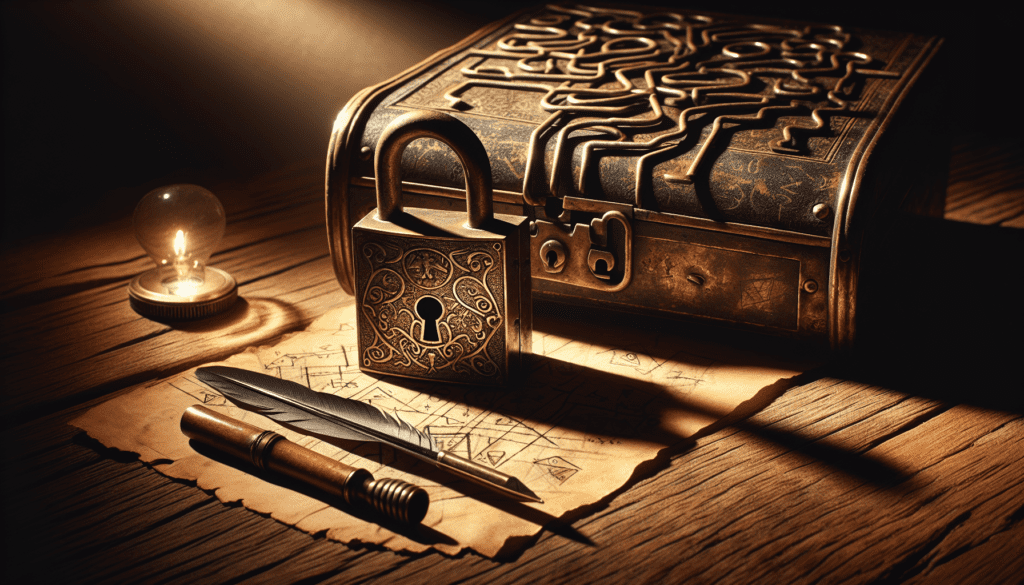Escape rooms have become increasingly popular over the years, challenging teams to solve puzzles and unravel mysteries in a confined space. But have you ever wondered what the minimum size for an escape room is? In this article, we will explore the factors that determine the size requirements for an escape room, taking into consideration the comfort and safety of participants. Whether you’re a seasoned escape room enthusiast or considering designing your own, understanding the minimum size for an escape room is crucial for creating an immersive and enjoyable experience.
Factors to Consider
When planning an escape room, there are several factors to consider in order to create an engaging and enjoyable experience for your players. These factors include the purpose of the escape room, the number of players, the types of puzzles and challenges, and additional features and themes.
Purpose of the Escape Room
The purpose of the escape room is an important consideration as it will dictate the overall theme and storyline of the experience. Are you looking to create a thrilling adventure that will challenge players’ problem-solving skills, or do you want to focus on team-building and communication? Understanding your purpose will help guide the design and development of the escape room.
Number of Players
The number of players that can participate in an escape room session will determine the size and layout of the space. Consider whether your escape room will cater to smaller groups or accommodate larger teams. This will impact the complexity of the puzzles and challenges, as well as the overall dynamics and flow of the experience.
Types of Puzzles and Challenges
The types of puzzles and challenges you incorporate into your escape room will play a significant role in the overall enjoyment and success of the experience. Consider a mix of mental, physical, and interactive puzzles to cater to a wide range of interests and skill levels. Engaging puzzles that encourage teamwork and problem-solving will enhance the player experience and keep them coming back for more.
Additional Features and Themes
To create a truly immersive and memorable escape room experience, consider incorporating additional features and themes. This could involve using technology, sound effects, and props to enhance the atmosphere and create a sense of realism. By immersing players in a captivating world, you can elevate the overall experience and leave a lasting impression.
The Essentials
Creating an escape room that meets the basic requirements is essential to ensure a safe and engaging experience for your players. Consider the following essentials when designing your escape room.
Minimum Room Dimensions
The minimum room dimensions will vary depending on the number of players you plan to accommodate and the complexity of the puzzles. Generally, a minimum of 150 to 200 square feet is recommended per player to allow for ample space to move around and solve puzzles comfortably.
Door and Entryway
The door and entryway to the escape room should be well-designed to create a seamless transition into the experience. Consider using a sturdy door that adds to the immersion and complements the overall theme of the escape room. Additionally, ensure that the entryway is accessible and provides clear instructions on how to enter the room.
Ceiling Height
The ceiling height of the escape room is an important consideration to ensure the comfort and safety of your players. A minimum ceiling height of 8 feet is recommended to provide enough headroom for players to move freely without feeling cramped or restricted. However, consider incorporating higher ceilings if your theme requires the use of tall props or structures.
Flooring and Walls
Choosing the right flooring and walls for your escape room is crucial to creating a cohesive and immersive environment. Opt for durable and easy-to-clean flooring materials that can withstand heavy foot traffic and potential spills. Similarly, choose walls that are sturdy and soundproof to minimize distractions from outside noise and create a more immersive experience.
Escape Route Accessibility
In addition to the main entrance, it is important to consider the accessibility of the escape route. Ensure that there is a clear and unobstructed path for players to exit the room in case of emergencies. This may involve installing additional emergency exits or providing clear instructions on how to navigate the escape route.

Safety and Comfort
Ensuring the safety and comfort of your players should be a top priority when designing an escape room. Consider the following factors to create a safe and enjoyable environment.
Adequate Lighting and Ventilation
Proper lighting is essential to create a visually appealing and immersive escape room experience. Ensure that each area of the room is well-lit to allow players to easily navigate and solve puzzles. Additionally, consider incorporating ambient lighting that complements the theme of the escape room.
Furthermore, proper ventilation is crucial to maintain a comfortable temperature and air quality within the escape room. Adequate air circulation will prevent the room from becoming stuffy or uncomfortable, especially if the escape room is designed to accommodate larger groups.
Temperature and Climate Control
Maintaining a comfortable temperature within the escape room is important to ensure the comfort of your players. Consider installing a reliable heating, ventilation, and air conditioning system that can maintain an optimal temperature throughout the year. This will help create a pleasant environment regardless of the external climate.
Emergency Exits and Fire Safety
Safety should always be a top priority in any escape room. Ensure that there are clearly marked emergency exits that are easily accessible in case of emergencies. Regularly inspect and maintain these exits to ensure they are in good working condition at all times.
Additionally, implement fire safety measures such as smoke detectors, fire extinguishers, and an alarm system. Conduct regular fire drills and train your staff on proper evacuation procedures to ensure the safety of your players in the event of a fire.
Comfortable Seating and Standing Areas
Providing comfortable seating and standing areas within the escape room is important to allow players to take a break if needed. Consider incorporating benches or seating options that complement the theme of the escape room and provide a place for players to sit and strategize during the game. This will enhance the overall comfort and enjoyment of the experience.
Technical Requirements
Integrating the right technology and technical features into your escape room can greatly enhance the overall experience for your players. Consider the following technical requirements when designing your escape room.
Electrical Outlets and Wiring
Ensure that your escape room has an adequate number of electrical outlets to power any technology and props used within the room. Strategically plan the placement of outlets to minimize the use of extension cords and create a neat and organized environment. Additionally, ensure that all wiring is safely installed and meets electrical safety standards.
Wi-Fi and Internet Connectivity
Depending on the complexity of your escape room, you may need to provide Wi-Fi and internet connectivity for certain puzzles and challenges. This could involve incorporating online clues or interactive elements that require internet access. Provide a reliable and secure Wi-Fi connection to enhance the overall experience for your players.
Audio and Visual Systems
Utilizing audio and visual systems can greatly enhance the immersion and storytelling of your escape room. Consider incorporating high-quality sound systems to provide atmospheric music, sound effects, and narration. Additionally, use strategically placed screens and projectors to deliver visual cues and instructions to players.
Security and Surveillance
Ensure the security and surveillance of your escape room by installing a reliable security system. This could involve the use of security cameras to monitor the gameplay and ensure the safety of your players. Additionally, consider implementing access control systems to track and manage player entry and exit.

Accessibility and Regulations
Complying with building codes and regulations is essential to ensure the accessibility and safety of your escape room. Consider the following factors when designing your escape room.
Compliance with Building Codes
Ensure that your escape room meets all relevant building codes and regulations in your location. This may involve obtaining permits and inspections to ensure compliance with fire safety, electrical, and accessibility codes. Consult with local authorities and building professionals to ensure that your escape room meets all necessary requirements.
Accessible Facilities for Disabled Players
It is crucial to make your escape room accessible for players with disabilities. This may involve incorporating features such as ramps, wider doorways, and accessible puzzles to ensure that everyone can fully participate in the experience. Consult with accessibility experts to ensure that your escape room meets the needs of all players.
Health and Sanitation Requirements
Maintaining a clean and hygienic environment is important to protect the health and safety of your players. Implement regular cleaning and sanitation protocols to ensure that your escape room meets all relevant health and sanitation requirements. This may involve regular inspections and the use of appropriate cleaning products.
Insurance and Liability Considerations
Obtaining the right insurance coverage is important to protect your escape room business from potential liabilities. Consult with insurance professionals to identify the appropriate coverage for your escape room, including general liability insurance and property insurance. This will provide financial protection in the event of accidents or other unforeseen incidents.
Budget and Space Optimization
Effectively managing your budget and optimizing the use of space can greatly impact the success and profitability of your escape room. Consider the following factors when planning your escape room.
Cost Constraints and Return on Investment
Understand your budget constraints and carefully consider the costs associated with building and running an escape room. Ensure that your return on investment justifies the initial investment and ongoing operational expenses. Consider alternative financing options or partnerships to help manage costs and maximize profitability.
Creative Use of Limited Space
If you have limited space available, get creative with your layout and puzzle designs. Consider utilizing vertical space by incorporating multi-level puzzles or challenges. Maximize the use of wall space by installing interactive elements or puzzles. By thinking outside the box, you can create a compelling escape room experience even in a smaller space.
Multi-room Layouts and Alternative Setups
Consider designing your escape room to incorporate multiple rooms or areas. This allows for more complex puzzles and challenges that require teamwork and communication between players in different spaces. Additionally, explore alternative setups such as mobile or pop-up escape rooms that can be easily transported and set up in different locations.
Expansion Potential and Future Growth
When designing your escape room, consider the potential for future growth and expansion. Plan your layout and infrastructure in a way that allows for easy modifications or additions to accommodate more players or themes. By considering scalability and future growth, you can ensure that your escape room remains relevant and profitable in the long term.

Tailoring the Experience
Tailoring the escape room experience to your target audience and creating a unique and immersive environment is key to success. Consider the following factors when designing your escape room.
Target Audience and Player Demographics
Identify your target audience and understand their preferences and interests. Consider factors such as age, interests, and experience level when designing puzzles and challenges. This will help ensure that your escape room appeals to your intended audience and delivers a memorable experience.
Thematic Design and Immersive Elements
Create an immersive environment by carefully designing the theme and elements of your escape room. Choose a theme that resonates with your target audience and build a storyline that engages players from the moment they step into the room. Incorporate props, sound effects, and visuals that align with the theme to enhance the overall immersion.
Personalization and Customization Options
Provide options for personalization and customization within your escape room. This could involve allowing players to choose their own difficulty level or providing different paths or endings based on player choices. By offering customization options, you can create a more engaging and personalized experience for your players.
Room Difficulty and Replayability
Strike a balance between challenge and enjoyment by carefully designing the difficulty level of your escape room. Consider offering multiple difficulty options to cater to different skill levels and ensure that both beginners and experienced players can enjoy the experience. Additionally, design your puzzles and challenges to allow for replayability, providing incentives for players to come back and try again.
Expert Recommendations
Seeking advice from escape room professionals and benchmarking successful escape rooms can greatly enhance the design and operation of your own escape room. Consider the following recommendations when planning your escape room.
Escape Room Industry Standards
Research and familiarize yourself with industry standards and best practices for escape room design. This could involve attending industry conferences, networking with other escape room owners, and keeping up-to-date with the latest trends and innovations. By understanding industry standards, you can ensure that your escape room meets or exceeds expectations.
Consulting Escape Room Professionals
Consider hiring or consulting with escape room professionals who have experience in designing and operating successful escape rooms. These professionals can provide valuable insights and recommendations based on their own experiences and expertise. They may have a fresh perspective and ideas that can elevate the quality of your escape room.
Benchmarking Successful Escape Rooms
Study successful escape rooms and analyze what makes them stand out. This could involve visiting other escape rooms, reading customer reviews, and researching popular escape room franchises. By understanding the elements that contribute to their success, you can incorporate similar strategies into your own escape room design.
Incorporating Customer Feedback
Regularly collect and analyze customer feedback to continuously improve and refine your escape room. Pay attention to both positive feedback and areas for improvement. This feedback can provide valuable insights into the player experience and help you identify areas where adjustments or enhancements may be needed.

Case Studies
Studying case studies of small-scale escape room examples and success stories in compact spaces can provide valuable inspiration and guidance when designing your own escape room. Consider the following case studies to gain insights into different approaches and challenges.
Small-Scale Escape Room Examples
Explore small-scale escape room examples to understand how innovative design and creative use of space can create captivating experiences. These examples may demonstrate how to incorporate multi-room layouts, thematic storytelling, and interactive elements in a limited space. By studying these examples, you can gain inspiration for your own escape room design.
Success Stories in Compact Spaces
Read success stories of escape rooms that have achieved great success despite being located in compact spaces. These stories may offer insights into how to optimize the use of space, cater to a specific target audience, and create a unique and memorable experience. Learn from their strategies and adapt them to suit your own escape room.
Challenges and Lessons Learned
Study the challenges and lessons learned by other escape room owners and operators. Learning from their experiences can help you avoid potential pitfalls and make informed decisions throughout the design and operation of your escape room. Understanding the common challenges faced by others can prepare you for potential obstacles and help you adapt your plans accordingly.
The Road to Success
Building a successful escape room requires careful planning, effective marketing, and a commitment to continuous improvement. Consider the following factors when embarking on your journey to escape room success.
Market Research and Feasibility Studies
Conduct thorough market research and feasibility studies to understand the demand for escape rooms in your area. Analyze the competition, identify your target audience, and evaluate the potential profitability of your escape room business. This will help you make informed decisions throughout the planning and development process.
Designing a Compelling Escape Room Experience
Invest time and effort into designing a compelling escape room experience that captivates your players. Pay attention to every detail, from the storyline and puzzles to the immersive elements and atmosphere. By creating a unique and engaging experience, you can differentiate your escape room from the competition and attract repeat customers.
Effective Marketing and Promotion
Develop a comprehensive marketing strategy to attract potential players to your escape room. Utilize both online and offline marketing channels, such as social media, email marketing, and local advertising, to reach your target audience. Create a visually appealing website and leverage customer testimonials to showcase the unique features and benefits of your escape room.
Continuous Improvement and Innovation
Embrace a culture of continuous improvement and innovation within your escape room business. Regularly review and update your puzzles, challenges, and themes to ensure that they remain fresh and exciting for your players. Implement a feedback loop with your customers to gain insights and ideas for improvement. By continuously evolving and innovating, you can stay ahead of the competition and provide a memorable experience for your players.
In conclusion, designing a successful escape room requires careful consideration of various factors, from the purpose and target audience to technical requirements and safety regulations. By thoroughly planning and executing each aspect of your escape room, you can create a captivating and immersive experience that keeps players coming back for more. Remember to continuously evaluate and improve your escape room based on customer feedback and industry best practices to ensure long-term success.

